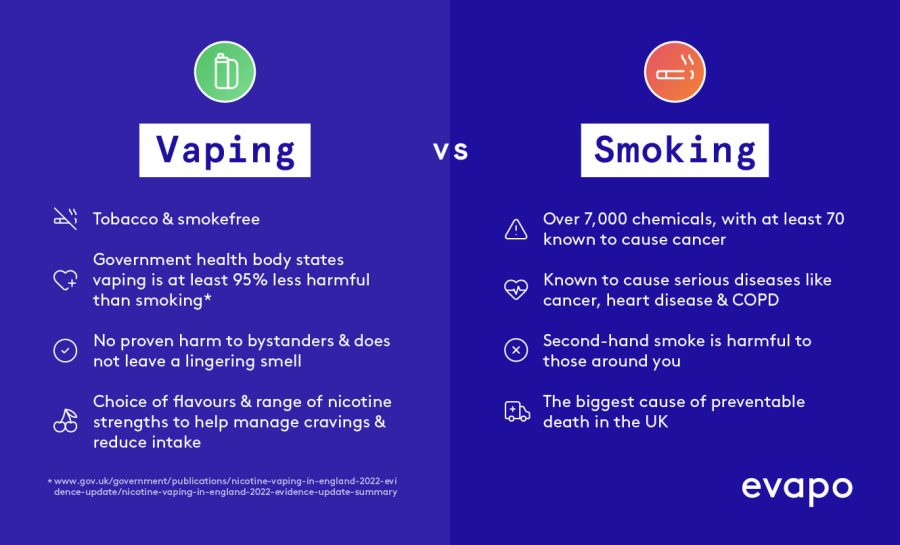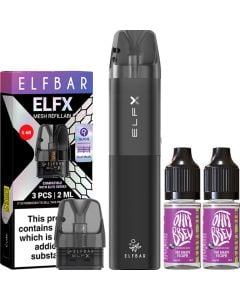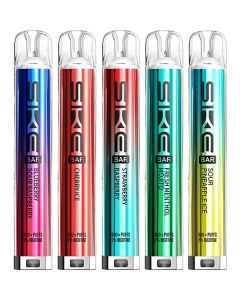While smoking and vaping are sometimes put into a similar category, they actually are very different and those differences are subject to a lot of debate.
In this guide, we offer a breakdown of the key differences between the two. Dive in for a clear, evidence-based comparison of the various aspects of vaping and smoking and be certain you have the knowledge you need if you are considering the benefits of a smoke-free life.
The biggest difference: combustion vs vapour
One of the fundamental and most essential differentiators between smoking and vaping is combustion. In regards to smoking, this is the process of setting tobacco alight so that it produces smoke, which can be inhaled as a way of absorbing nicotine. An e-cigarette uses neither tobacco nor combustion, setting it apart from smoking.
What happens when you smoke?
Smoking requires the combustion of tobacco, which burns at a high temperature. This creates smoke which contains thousands of chemicals, including tar and carbon monoxide. It is these chemicals and the way they are released that are the primary causes of smoking-related harm.
According to the British Heart Foundation, the chemicals released during smoking significantly increase your risk of developing heart and circulatory diseases, by causing a build-up of fatty material which can cause clogs in your arteries. This reduces blood flow and increases the risk for heart attacks or strokes.
Cancer Research UK also states that at least 70 of the chemicals found in cigarette smoke are known to cause cancer. Some chemicals damage DNA and others make it harder for DNA to repair itself, both factors can lead to cancer.
How does vaping work?
Vaping works by heating an e-liquid to a much lower temperature than that of combustion. This process produces a vapour rather than smoke, which allows the user to continue using nicotine without the need for combustion.
E-liquids do not contain any tobacco. Instead, they are made from food grade ingredients, which means they do not contain substances like tar and carbon monoxide. In the UK, the ingredients used in nicotine-containing e-liquids are strictly regulated, and any new e-liquids must be approved by the Medicines & Healthcare products Regulatory Agency (MHRA) before they can be sold, to ensure safety and quality.

Health & harm reduction
The key reason that people make the switch from cigarettes to vaping is the reduction in harm. In eliminating tobacco and the combustion process, vaping offers an alternative to smoking that a number of public health bodies has endorsed.
Public health body endorsements
Public health organisations, such as the Office for Health Improvement and Disparities (OHID) and the Royal College of Physicians, have concluded that vaping offers a safer way to consume nicotine. In fact, research from the OHID has confirmed that vaping is "at least 95% less harmful than smoking".
Vaping is included on The National Institute for Health and Care Excellence (NICE) list of recommended smoking interventions and many stop smoking services now embrace vapes as one of the smoking cessation tools they offer. The Government’s swap to stop scheme, a programme which offered smokers a vape starter kit alongside behavioural support to help them quit the habit, endorsed and encouraged this switch.
Smoking vs vaping impact on the body
The differences between vaping and smoking can be seen through the impact on the body.
Smoking is the leading cause of preventable death in the UK, and continuing to smoke only increases the risk of smoking related illness and disease. However, by quitting cigarettes, health can be significantly improved.
Ex-smokers often experience dramatic improvements in their sense of smell and taste alongside the positive impact on lung and respiratory health when they quit. The NHS reports that after stopping smoking, breathing can feel easier within 72 hours. This is because the bronchial tubes have started to relax. Within 3 to 9 months, lung function increases by up to 10% and within a year, the risk of heart attack will have halved compared with a smoker. After 10 years, the risk of death from lung cancer has also halved.
While vaping is not risk-free, it poses a significantly lower risk than continuing to smoke. A study from the University of Catania found that making the switch to an e-cigarette allows your lungs to rebuild their defence against bacteria and viruses, thanks to the huge reduction of toxic chemicals being inhaled.
One of the biggest misconceptions around smoking and vaping is the idea that nicotine is as harmful as some of the toxic chemicals present in cigarettes. In fact, while nicotine is a highly addictive substance, it is not linked to cancer, lung disease, heart disease or stroke, according to the NHS.
Vaping allows you to replace your nicotine cravings without exposure to these other toxic chemicals. What’s more, the fact that e-liquids come in a variety of different nicotine strengths, including nicotine-free options, means that vaping can allow you to wean yourself off nicotine at the pace that suits you best.
Nicotine delivery of cigarettes vs vapes
While there is a physical element to the habit of smoking or act of vaping, nicotine consumption is the primary objective of both. So how do the processes differ?
Nicotine delivery and control
While smoking and vaping both deliver nicotine (providing you are using an e-liquid that contains nicotine), vaping offers far greater control alongside a satisfying experience. Although cigarettes can contain anywhere from 8 mg – 20 mg of nicotine, the average nicotine absorption from each cigarette smoked is around 1 – 2 mg. This means there is very little room to control your nicotine intake from smoking. It is mainly just determined by how many cigarettes you smoke per day.
However, there are a wide range of e-liquid strengths available, from 0 mg up to 20 mg/ml, allowing you to better tailor your nicotine intake. This makes it possible to choose the nicotine strength that best suits your previous smoking habits and allows you to manage cravings effectively, as well as giving you the option of reducing your intake over time.
In addition to choosing the nicotine strength that best suits your cravings, e-liquids also offer the opportunity to pick between freebase nicotine and nic salts so you can find the one that feels most comfortable to you. Nic salts are designed to offer intense flavour and a smooth throat feel, while freebase nicotine provides a throat hit that is more akin to smoking. You can find out more in our guide to freebase vs nic salts.
Practical differences between smoking cigarettes and vaping
Alongside harm reduction and nicotine delivery, there are a few other practical differences between vaping and smoking that are well worth taking into consideration.
Cost comparison
The long term-cost of vaping is typically a much more economical choice than the long-term cost of smoking. A relatively small but interesting study in the US found that monthly e-cigarette spending was approximately a third cheaper than smoking. Research from UCL also shows that smokers could save up to £780 a year when making the switch from cigarettes to vapes.
There are also a great range of options to choose from when it comes to vape kits, meaning users are able to search for ones that best suit their budgets and needs.
Smell and odour
Another key consideration is the smell and odour associated with smoking cigarettes. While vaping does produce a scent, it does not linger in hair or on the body or clothes in the way that cigarette smoke does. This means it has a much shorter lasting smell that quickly dissipates.
Social acceptance
While there are some instances where smoking and vaping are looked at in a similar light (such as in buildings where there is a public smoking and vaping area), the public perception of vaping is generally more favourable than the one for smoking. This is largely due to the lack of smoke and the fact that vaping does not leave a lingering odour.
The takeaway: empowering you to make an informed decision
Essentially, the biggest and most significant difference between smoking and vaping is the act of combustion and the use of tobacco. Because vaping allows you to inhale nicotine without the need to light and burn tobacco, it offers a significant reduction in harm in comparison to smoking cigarettes.
When it comes to choosing a smoke-free alternative, the most important thing is to choose the option that serves you best. Now that you have all the facts you need about the differences between vaping and smoking, you are in a great position to weigh up your options. So why not explore our full range of vaping products and other smoking alternatives at Evapo as a step towards a smoke-free future?
Sources
Bhf.org.uk – 21/08/2025
Cancerresearchuk.org – 07/06/2023
Gov.uk – 16/08/2024
Gov.uk – 19/08/2015
Nice.org.uk – 04/02/2025
Gov.uk – 11/04/2023
Nhs.uk – 21/08/2025
Journals.sagepub.com – 12/08/2021
Nhs.uk – 21/08/2025
Pmc.ncbi.nlm.gov – 05/04/2024
UCL.com – 26/06/2019






























